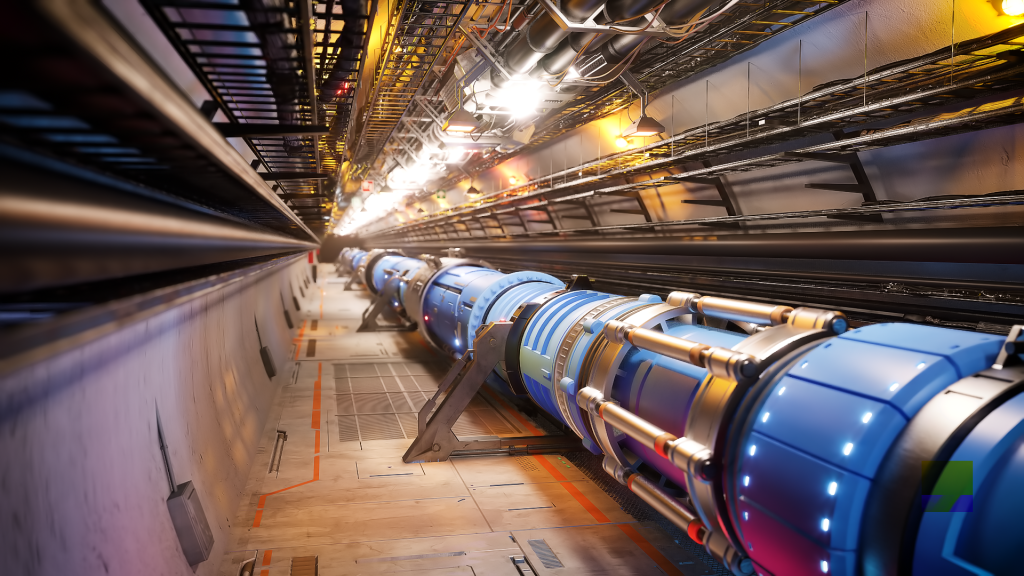CERN has taken an important step towards the next frontier in particle physics with a review of the feasibility study of the proposed future Circular Collider (FCC).
At a dedicated meeting on November 6-7, 2025, Council representatives from Member and Associate Member States reviewed multi-year studies and confirmed that the FCC is technically viable and there are no major obstacles.
This milestone sets the stage for what could become the world’s most powerful particle accelerator, designed to replace the Large Hadron Collider (LHC) and push the boundaries of our understanding of the universe.
What is the circular collider of the future?
Future Circular Collider is a next-generation particle accelerator proposed as a successor to the existing LHC, which will cease operation around 2041.
The concept envisions a circular tunnel with a circumference of approximately 90 to 100 kilometers. Its design outlines two major phases:
FCC‑ee: Electron-positron collider designed as a “Higgs factory” to precisely search for electroweak particles. FCC‑hh: A post-proton collider operating at energies of around 100 TeV, many times the energy of the current LHC, opening the door to entirely new physics beyond the Standard Model.
Beyond particle physics, the FCC aims to drive breakthroughs in accelerator, superconductivity, and detector technologies that can have societal and industrial ramifications.
Research background and timeline
This feasibility work follows the 2020 update of the European Strategy for Particle Physics (ESPP), which called on CERN and its partners to investigate future hadron colliders with center-of-mass energies of at least 100 TeV, starting with the electron-positron Higgs factory phase.
CERN officially launched the study in 2021, with the supervision of an independent expert body, and the final report was published on March 31, 2025. The November Board session will include a critical review of submitted documents and set the stage for future decisions.
Council conclusions and future direction
In its deliberations, the Board reaffirmed CERN’s ambition to remain a global hub for cutting-edge accelerator science and determined that the FCC will serve as a visionary platform to address major open questions in particle physics, such as the precision study of the Higgs boson and the exploration of physics beyond the Standard Model.
The Board welcomed the financial modeling work already undertaken, including funding scenarios and initial commitments, but called for further work on territorial implementation (as the tunnel would cross the French and Swiss borders), environmental impacts, cost uncertainty, risk management, and communication of scientific and social benefits.
Importantly, the conclusions state that the FCC’s feasibility study provides the basis for continuing the project and that previous funding scenarios and commitments provide the basis for securing the full funding commitment required for approval. A final decision on whether to establish the FCC is expected to be made around 2028.
A new era of particle physics research
Launched in 2008, the LHC remains the world’s most powerful particle collider. But when that ends around 2041, Europe will need a successor in the field if it is to maintain its leadership in high-energy physics.
By achieving much higher energies or with dramatically improved precision at lower energies, future circular colliders could break new ground, including understanding dark matter, exploring mass production mechanisms beyond the Higgs boson, and understanding entirely new forces and particles.
Necessary technologies such as ultra-high field magnets, advanced detectors, new cryogenics, and large-scale civil engineering work will stimulate innovation beyond pure science.
Now that the feasibility study has been reviewed and approved to continue, CERN member states will now undertake further preparatory work, including refining cost estimates, securing commitments from national authorities and industry, advancing site and civil engineering plans, and providing a complete social case for the project.
At the same time, the following updates to ESPP will be made: Recommendations will be developed at a community-led meeting in Ascona, Switzerland in December 2025 and will be reflected in a formal Board decision in May 2026.
The FCC case will be featured prominently. The board then aims to make a build-or-no-build decision around 2028.
If approved, construction would begin in the early 2030s, with initial operations planned for the end of the LHC program in the mid-2040s, ensuring continued European leadership in high-energy physics.
Although many technical, financial, and environmental issues remain to be resolved, the momentum is now undeniable. Europe is preparing for the next breakthrough in accelerator science, and the FCC is taking center stage.
Source link

